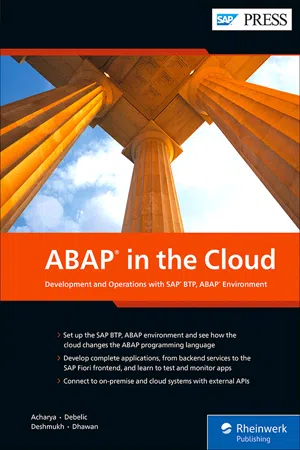
ABAP in the Cloud
Development and Operations with SAP BTP, ABAP Environment
- 316 pages
- English
- ePUB (mobile friendly)
- Available on iOS & Android
ABAP in the Cloud
Development and Operations with SAP BTP, ABAP Environment
About this book
SAP BTP, ABAP environment requires specialized knowledge of language limits and development environment—let this book be your guide! Begin by provisioning a trial instance and setting up ABAP Development Tools in Eclipse. Then, walk step-by-step through building an app using the ABAP RESTful application programming model, developing backend services, and creating SAP Fiori apps. Connect your cloud-based ABAP applications to on-premise and cloud systems and learn how to manage and maintain those applications. ABAP's not dead, it's in the cloud! Highlights include: 1) ABAP Development Tools in Eclipse
2) SAP BTP, Cloud Foundry environment
3) ABAP RESTful application programming model
4) Application development
5) Backend services
6) SAP Fiori
7) Consuming APIs
8) Identity and access management
9) Application lifecycle management
10) Monitoring and security
Frequently asked questions
- Essential is ideal for learners and professionals who enjoy exploring a wide range of subjects. Access the Essential Library with 800,000+ trusted titles and best-sellers across business, personal growth, and the humanities. Includes unlimited reading time and Standard Read Aloud voice.
- Complete: Perfect for advanced learners and researchers needing full, unrestricted access. Unlock 1.4M+ books across hundreds of subjects, including academic and specialized titles. The Complete Plan also includes advanced features like Premium Read Aloud and Research Assistant.
Please note we cannot support devices running on iOS 13 and Android 7 or earlier. Learn more about using the app.
Information
1 Getting Started
1.1 SAP BTP, Cloud Foundry Environment
Table of contents
- Dear Reader
- Notes on Usage
- Table of Contents
- Preface
- 1 Getting Started
- 2 Developing Applications
- 3 Consuming External APIs
- 4 Operating Applications
- 5 Next Steps
- The Authors
- Index
- Service Pages
- Legal Notes